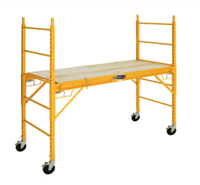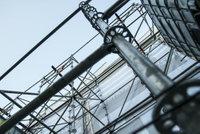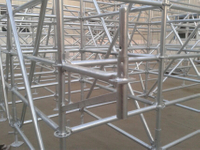Content Menu
● Introduction to Tube & Fitting Scaffolding
● Basic Components
● Safety Considerations
>> Inspection and Maintenance
>> Assembly and Dismantling
>> Personal Protective Equipment (PPE)
>> Fall Protection
>> Weather Conditions
● Assembly Techniques
● Regulatory Compliance
>> TG20 Guidance
>> Training and Certification
● Best Practices for Use
>> Efficient Use
>> Cost-Effectiveness
● Specialized Applications
● Conclusion
● FAQ
>> 1. What are the basic components of tube & fitting scaffolding?
>> 2. What safety measures should be taken when using tube & fitting scaffolding?
>> 3. What is the purpose of the NASC's TG20 guide?
>> 4. How often should scaffolding be inspected?
>> 5. What are the key considerations for assembling tube & fitting scaffolding?
● Citations:
Tube & fitting scaffolding is a widely used method in construction and maintenance projects for accessing high places safely. It consists of individual components like tubes and fittings that are assembled to form a sturdy structure. This article will delve into the best practices for using tube & fitting scaffolding, including safety guidelines, assembly techniques, and regulatory compliance.
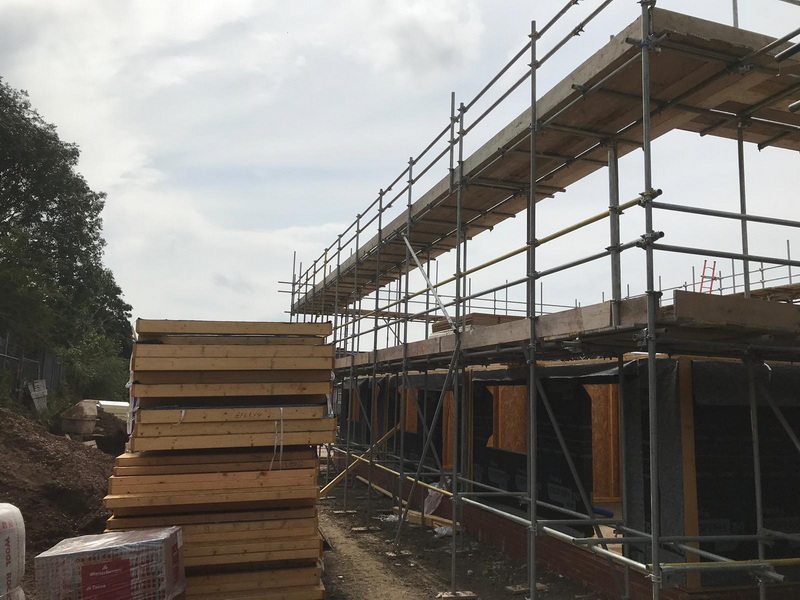
Introduction to Tube & Fitting Scaffolding
Tube & fitting scaffolding is versatile and can be customized to fit various project needs. It is commonly used in construction, repair, and maintenance of buildings and industrial plants. The components include galvanized tubes of different lengths and fittings such as couplers and clamps, which are used to secure the structure together.
Basic Components
- Tubes: These are the primary structural elements, typically made from galvanized steel to resist corrosion. They come in various lengths, usually between 4 to 16 feet.
- Fittings: These include couplers (e.g., right-angle and swivel couplers) that connect tubes at different angles. The fittings are tightened using a tube and clamp wrench to ensure stability.
Safety Considerations
Safety is paramount when working with scaffolding. Here are some key considerations:
Inspection and Maintenance
Before use, scaffolding must be inspected by a qualified person to ensure all components are in good condition and properly assembled. Regular maintenance is crucial to prevent wear and tear.
Assembly and Dismantling
Assembly should follow established guidelines, such as those outlined in the NASC's TG20 guide for tube and fitting scaffolding in the UK. Dismantling should be done systematically to avoid accidents.
Personal Protective Equipment (PPE)
Workers must wear appropriate PPE, including hard hats, safety harnesses, and non-slip footwear.
Fall Protection
Fall protection systems, such as guardrails and safety nets, should be installed to prevent falls from the scaffold. Workers should also be trained in the use of personal fall arrest systems.
Weather Conditions
Scaffolding should not be used during adverse weather conditions like strong winds, heavy rain, or snow. These conditions can compromise the stability of the scaffold.
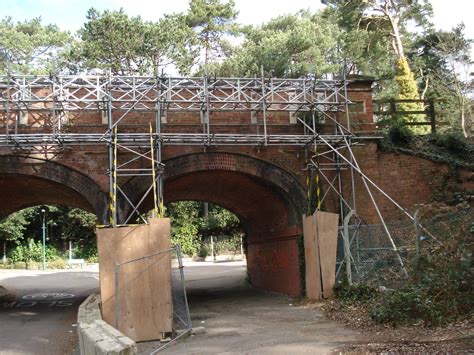
Assembly Techniques
Proper assembly is critical for the stability and safety of the scaffolding. Here are some steps to follow:
1. Base Preparation: Ensure the base plates are securely placed on firm ground. Use leveling jacks if necessary to achieve a level surface.
2. Vertical and Horizontal Bracing: Install vertical bracing across the width of the scaffold and horizontal bracing at a 45-degree angle to provide stability.
3. Guardrails and Toeboards: Install guardrails and toeboards to prevent falls and ensure a safe working platform.
4. Tying and Guying: Secure the scaffold to the building if the height exceeds four times the minimum base dimension. This helps prevent the scaffold from tipping over.
Regulatory Compliance
Compliance with local and national regulations is essential. In the UK, the NASC's TG20 guide provides comprehensive guidance for tube and fitting scaffolding. It covers standard designs, safety practices, and compliance with European standards like BS EN 12811.
TG20 Guidance
TG20 offers detailed guidance on planning and managing scaffolding projects, including independent scaffolds, birdcages, and chimney scaffolds. It emphasizes the importance of competent design for non-standard scaffolding.
Training and Certification
Ensure all personnel involved in scaffolding work are properly trained and certified. This includes training in assembly, inspection, and safety procedures.
Best Practices for Use
Here are some best practices to ensure safe and efficient use of tube & fitting scaffolding:
- Training: Ensure all personnel involved in scaffolding work are properly trained and certified.
- Regular Inspections: Conduct regular inspections to identify and address any issues promptly.
- Load Management: Ensure the scaffold is not overloaded beyond its capacity. Follow the manufacturer's guidelines for load limits.
- Weather Conditions: Avoid using scaffolding during adverse weather conditions like strong winds or heavy rain.
Efficient Use
To maximize efficiency, plan the scaffold layout carefully to minimize reassembly and ensure easy access to all work areas. Use modular components to simplify assembly and disassembly.
Cost-Effectiveness
Tube & fitting scaffolding can be cost-effective due to its reusability and versatility. Proper maintenance and storage can extend the lifespan of the components.
Specialized Applications
Tube & fitting scaffolding can be adapted for specialized applications such as:
- Chimney Scaffolding: Requires careful planning to ensure stability and safety around chimneys.
- Bridge Scaffolding: Used for maintenance and repair of bridges, requiring specialized support systems.
- Industrial Scaffolding: Often used in industrial settings for maintenance and repair of machinery and equipment.
Conclusion
Tube & fitting scaffolding is a versatile and effective method for accessing high places, but its safety and efficiency depend on proper assembly, maintenance, and regulatory compliance. By following best practices and adhering to guidelines like TG20, construction teams can minimize risks and ensure successful project outcomes.
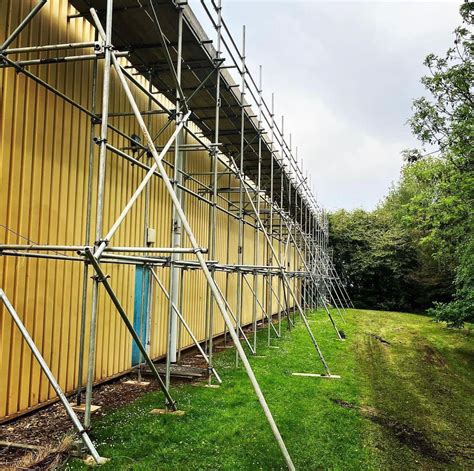
FAQ
1. What are the basic components of tube & fitting scaffolding?
Tube & fitting scaffolding consists of galvanized steel tubes and fittings such as couplers and clamps. These components are assembled to form a sturdy structure for accessing high places.
2. What safety measures should be taken when using tube & fitting scaffolding?
Safety measures include regular inspections, proper assembly and dismantling, use of personal protective equipment (PPE), and ensuring the scaffold is securely tied to the building if necessary.
3. What is the purpose of the NASC's TG20 guide?
The NASC's TG20 guide provides comprehensive guidance on good practices for tube and fitting scaffolding, covering standard designs, safety practices, and compliance with European standards.
4. How often should scaffolding be inspected?
Scaffolding should be inspected regularly by a qualified person before use and at intervals during its use to ensure it remains safe and secure.
5. What are the key considerations for assembling tube & fitting scaffolding?
Key considerations include ensuring a stable base, installing proper bracing, securing guardrails and toeboards, and tying the scaffold to the building if necessary.
Citations:
[1] https://www.highspeedtraining.co.uk/hub/scaffolding-safety-requirements/
[2] https://www.youtube.com/watch?v=ZM6Tlh_NAnQ
[3] https://blog.csdn.net/weixin_40289064/article/details/79669930
[4] https://safetyaccess.co.uk/news/tg2013-now-available/
[5] https://www.youtube.com/watch?v=61PDBVH-7i4
[6] https://max.book118.com/html/2017/0425/102172593.shtm
[7] https://besmart.ie/fs/doc/Construction/Construction_Documents/scaffolds_PoP_v11.pdf
[8] https://www.youtube.com/watch?v=veF4uSUtrEY
[9] https://www.labour.gov.hk/eng/public/os/B/mss.pdf













